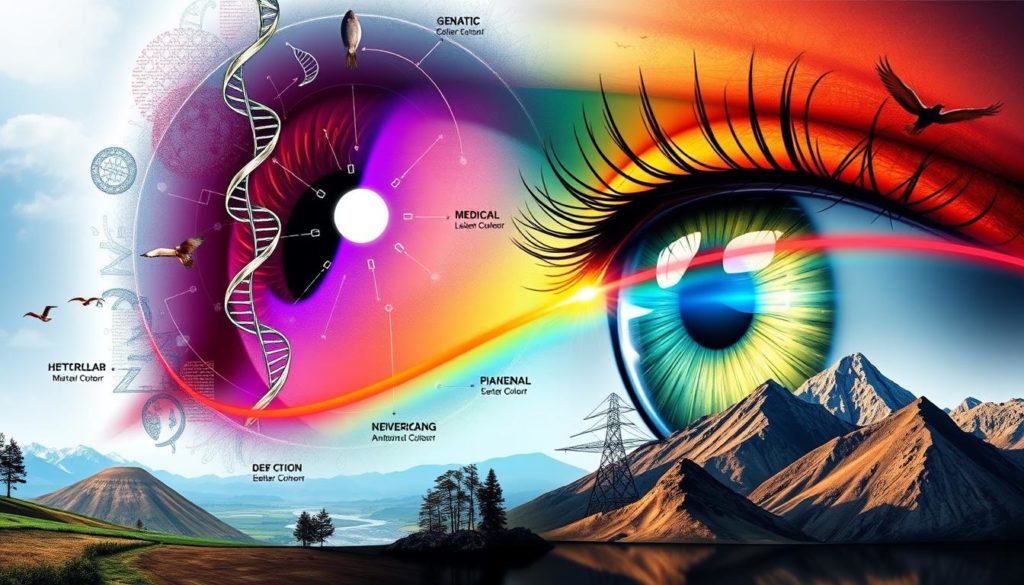“The eyes are the window to your soul.” – William Shakespeare’s timeless statement about the profound nature of our eyes takes on a unique resonance when exploring the mystique of understanding heterochromia.
Heterochromia, a captivating phenomenon where an individual has variations in eye color, has drawn intrigue and curiosity through the ages. Whether it’s the striking red and blue blend in David Bowie’s eyes or the distinct hues of Kate Bosworth’s, this condition elevates the notion of eye color uniqueness to an unparalleled level.
In this article, we will delve into the origins and causes of heterochromia, uncover its genetic and acquired factors, and understand its presence in humans. Join us on this journey to unravel the exquisite mystery behind heterochromia eye color.
What is Heterochromia?
Heterochromia is a rare condition where an individual’s eyes have different colors. This can show up in many ways, depending on the colors and how different they are. The eye color variations in heterochromia are unique and very interesting to see.

Definition and Overview
The term heterochromia refers to eyes with different colors. There are three main types:
- Complete Heterochromia: One eye is a completely different color from the other.
- Sectoral (or Partial) Heterochromia: A part of one iris is a different color from the rest.
- Central Heterochromia: A ring around the pupil is a different color than the rest of the iris.
History of Heterochromia
Heterochromia has been around for a long time. Ancient records and documents talk about it. It was often seen as mysterious or magical.
Historical figures like Aristotle and Alexander the Great were linked to it. Over time, our understanding of heterochromia has changed. Today, we know it’s caused by genetics or environmental factors.
Heterochromia is still fascinating and appears in art, literature, and pop culture. Famous people like Jane Seymour and Christopher Walken have highlighted its beauty and uniqueness.
Heterochromia Causes
Exploring heterochromia means looking at different reasons it happens. These reasons fall into two main groups: genetic and acquired causes.

Genetic Factors
Genetics are a big part of heterochromia. Certain genes can cause it, passed down from parents. This usually means the condition is there from birth.
It often comes from how melanin is spread in the iris. This is because of genetic instructions.
Acquired Factors
Acquired heterochromia, on the other hand, starts later in life. It’s not something you get from your parents. It can happen due to eye injuries, illnesses, or medication side effects.
Conditions like Horner’s syndrome and glaucoma can also cause it. Eye injuries can lead to post-traumatic heterochromia. This is when physical damage to the eye changes how pigment is spread.
Heterochromia in Humans
Heterochromia in humans is a fascinating genetic variation. It shows a lot of diversity across different populations. Looking into how common heterochromia is helps us understand its global spread and patterns.
Prevalence and Demographics
Heterochromia is not very common, but some groups have it more often. Caucasians tend to have it more than others. On the other hand, it’s less common in Africans and Asians.
| Population Group | Prevalence (%) |
|---|---|
| Caucasian | 0.4% |
| Asian | 0.05% |
| African | 0.07% |
Heterochromia is found all over the world, but it’s not everywhere. Studying the genetics behind it could help us learn more about this interesting eye condition.
Different Types of Heterochromia
Heterochromia is a fascinating condition where a person has two different colored eyes or variations in one eye. It comes in several forms, each unique. Let’s look at complete, sectoral, and central heterochromia to understand their characteristics and impact.
Complete Heterochromia
Complete heterochromia happens when one eye is a completely different color from the other. For example, one eye might be blue while the other is brown. This striking type can be inherited or result from genetic mutations or injury.
Sectoral Heterochromia
Sectoral heterochromia, also known as partial heterochromia, is when a segment of one eye is a different color. Unlike complete heterochromia, here the eye displays multiple hues in distinct sections. This creates a fascinating mosaic effect.
Central Heterochromia
Central heterochromia is when the eyes have a different color around the pupil (iris) compared to the outer ring. For instance, a person might have green eyes with a golden brown ring around their pupil. This type is often seen as the rarest and most mesmerizing.
| Type | Description | Example |
|---|---|---|
| Complete Heterochromia | Each eye is a completely different color | One blue eye and one brown eye |
| Sectoral Heterochromia | A segment of one eye is a different color from the rest | Green eye with a brown sector |
| Central Heterochromia | The iris has different colors from the center to the edge | Green eye with a golden ring around the pupil |
Understanding Heterochromia: A Genetic Perspective
Looking into heterochromia genetics shows us how our genes control eye color. It starts with knowing the important genes that decide eye pigmentation.
Heterochromia mainly deals with genes that control melanin spread. The OCA2 gene is key for melanin making, which affects iris color. The HERC2 gene helps control OCA2, making its effect stronger or weaker. This interaction is key to understanding heterochromia and its many forms.
Think about how these genes affect not just heterochromia but human genetics too:
| Gene | Function | Impact on Eye Color |
|---|---|---|
| OCA2 | Melanin production | Determines brown or blue eyes |
| HERC2 | Regulation of OCA2 | Influences the intensity of eye color |
| TYR | Tyrosinase production | Contributes to pigmentation patterns |
| SLC24A4 | Ion transport | Associated with green eye color |
This table gives a quick look at the main genes in heterochromia genetics. It shows how complex and detailed genetic interactions are. Knowing about heterochromia in this way helps us understand eye color better.
Heterochromia Symptoms and Diagnosis
It’s important to know about the signs and how doctors diagnose heterochromia. We’ll look at the symptoms and how to get a correct diagnosis.
Common Symptoms
Heterochromia can show different symptoms, but sometimes there are none. The main sign is a difference in eye color. Other symptoms include:
- Partial or complete difference in iris color between the two eyes.
- Changes in vision or light sensitivity, depending on the underlying cause.
- Presence of spots or discolorations within the iris itself.
Even though heterochromia is usually harmless, watch for other symptoms. They might mean there’s a health problem.
Diagnostic Techniques
Doctors use several ways to diagnose heterochromia. They want to know how big the difference is and why. Here are some methods:
- Comprehensive Eye Examination: A detailed look at the eyes to check the iris and find any problems.
- Genetic Testing: If it looks like genetics are involved, tests can find the cause.
- Visual Acuity Tests: These check if heterochromia affects vision, especially if there are other symptoms.
These tests help tell if heterochromia is just a cosmetic issue or if it needs more attention. Knowing the symptoms and getting a correct diagnosis is key for eye health.
Heterochromia Treatment Options
Heterochromia is usually harmless and doesn’t need medical help. But, some people might want treatment for looks or health reasons. There are many ways to treat heterochromia, each one fitting what the patient needs.
The treatment options for heterochromia largely depend on the underlying cause and the individual’s desired outcome.
- Prescription colored contact lenses to even out eye color differences.
- Laser eye surgery for those seeking a more permanent solution.
- Treatment for underlying medical conditions that might be causing the heterochromia, such as inflammation or trauma.
Here’s a closer look at the treatment options for heterochromia:
| Treatment Method | Advantages | Disadvantages |
|---|---|---|
| Colored Contact Lenses | Non-invasive, easy to use, customizable | Requires ongoing maintenance and care, potential for eye irritation |
| Laser Eye Surgery | Permanent solution, quick procedure | Expensive, possible side effects |
| Medical Treatment | Treats underlying cause, can improve overall eye health | May not change eye color, potential side effects |
Choosing the right heterochromia treatment is important. It should be talked over with an eye doctor. They can help pick the best option for you.
Fascinating Heterochromia Facts
Heterochromia is a rare eye condition that makes eyes stand out. It affects only about 1% of the world’s population. People with heterochromia often get a lot of attention because of their unique eye colors.
But heterochromia isn’t just for humans. Many famous pets, like David Bowie’s cat, have it too. These pets become stars because of their eye colors. Seeing heterochromia in animals is just as amazing as it is in humans.
Some people think heterochromia means you’re sick. But it’s usually harmless and shows how different we all are. Celebrities like Mila Kunis and Jane Seymour have heterochromia and are loved for it. Their acceptance helps show how beautiful and special heterochromia is.
FAQ
What is heterochromia?
Heterochromia is when a person has eyes of different colors. This can be from birth or happen later due to injury or illness.
What causes heterochromia?
It can come from genes or happen later due to injury, illness, or medication.
How common is heterochromia in humans?
It’s rare in humans. It’s more common in animals. The frequency varies by population and ethnicity.
Are there different types of heterochromia?
Yes, there are three types. Complete heterochromia means each eye is a different color. Sectoral heterochromia is when part of one eye is different. Central heterochromia has multiple colors in the iris.
Is heterochromia linked to any health problems?
Usually, it’s harmless. But if it changes or comes with other symptoms, it might mean there’s a health issue.
How is heterochromia diagnosed?
An eye doctor can diagnose it with a simple exam. They might use special tools to see more details.
Can heterochromia be treated?
Treatment is rare unless it’s caused by another condition. Cosmetic contact lenses can change eye color for looks.
Is heterochromia hereditary?
Yes, it can be passed down through genes. It often runs in families.
Are there any famous people with heterochromia?
Yes, like Mila Kunis and Kate Bosworth. Their unique eyes often get noticed and admired.
What are some interesting facts about heterochromia?
It’s not just for humans; animals like cats and dogs can have it too. It’s also found in myths and folklore, adding to its mystery.


